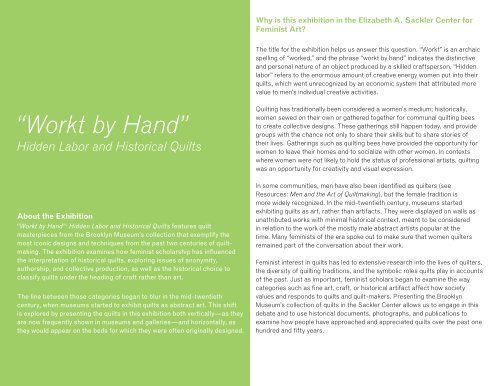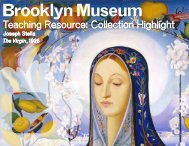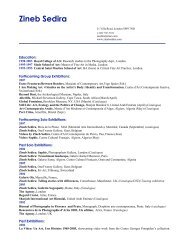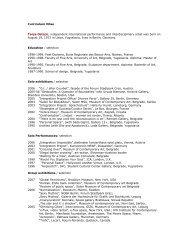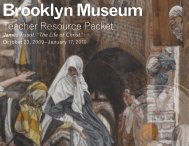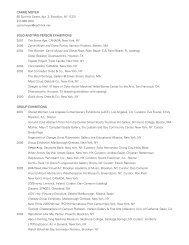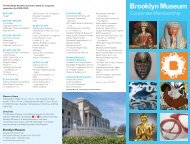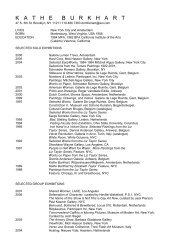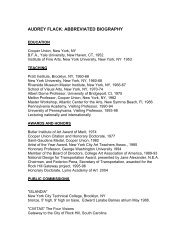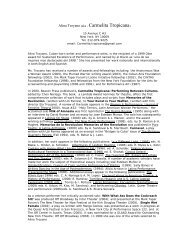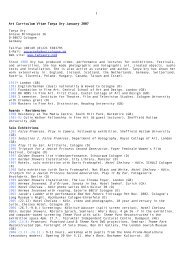"Workt by Hand": Hidden Labor and Historical Quilts
"Workt by Hand": Hidden Labor and Historical Quilts
"Workt by Hand": Hidden Labor and Historical Quilts
You also want an ePaper? Increase the reach of your titles
YUMPU automatically turns print PDFs into web optimized ePapers that Google loves.
Why is this exhibition in the Elizabeth A. Sackler Center for<br />
Feminist Art?<br />
The title for the exhibition helps us answer this question. “<strong>Workt</strong>” is an archaic<br />
spelling of “worked,” <strong>and</strong> the phrase “workt <strong>by</strong> h<strong>and</strong>” indicates the distinctive<br />
<strong>and</strong> personal nature of an object produced <strong>by</strong> a skilled craftsperson. “<strong>Hidden</strong><br />
labor” refers to the enormous amount of creative energy women put into their<br />
quilts, which went unrecognized <strong>by</strong> an economic system that attributed more<br />
value to men’s individual creative activities.<br />
“<strong>Workt</strong> <strong>by</strong> H<strong>and</strong>”<br />
<strong>Hidden</strong> <strong>Labor</strong> <strong>and</strong> <strong>Historical</strong> <strong>Quilts</strong><br />
Quilting has traditionally been considered a women’s medium; historically,<br />
women sewed on their own or gathered together for communal quilting bees<br />
to create collective designs. These gatherings still happen today, <strong>and</strong> provide<br />
groups with the chance not only to share their skills but to share stories of<br />
their lives. Gatherings such as quilting bees have provided the opportunity for<br />
women to leave their homes <strong>and</strong> to socialize with other women. In contexts<br />
where women were not likely to hold the status of professional artists, quilting<br />
was an opportunity for creativity <strong>and</strong> visual expression.<br />
About the Exhibition<br />
“<strong>Workt</strong> <strong>by</strong> H<strong>and</strong>”: <strong>Hidden</strong> <strong>Labor</strong> <strong>and</strong> <strong>Historical</strong> <strong>Quilts</strong> features quilt<br />
masterpieces from the Brooklyn Museum's collection that exemplify the<br />
most iconic designs <strong>and</strong> techniques from the past two centuries of quiltmaking.<br />
The exhibition examines how feminist scholarship has influenced<br />
the interpretation of historical quilts, exploring issues of anonymity,<br />
authorship, <strong>and</strong> collective production, as well as the historical choice to<br />
classify quilts under the heading of craft rather than art.<br />
The line between those categories began to blur in the mid-twentieth<br />
century, when museums started to exhibit quilts as abstract art. This shift<br />
is explored <strong>by</strong> presenting the quilts in this exhibition both vertically—as they<br />
are now frequently shown in museums <strong>and</strong> galleries—<strong>and</strong> horizontally, as<br />
they would appear on the beds for which they were often originally designed.<br />
In some communities, men have also been identified as quilters (see<br />
Resources: Men <strong>and</strong> the Art of Quiltmaking), but the female tradition is<br />
more widely recognized. In the mid-twentieth century, museums started<br />
exhibiting quilts as art, rather than artifacts. They were displayed on walls as<br />
unattributed works with minimal historical context, meant to be considered<br />
in relation to the work of the mostly male abstract artists popular at the<br />
time. Many feminists of the era spoke out to make sure that women quilters<br />
remained part of the conversation about their work.<br />
Feminist interest in quilts has led to extensive research into the lives of quilters,<br />
the diversity of quilting traditions, <strong>and</strong> the symbolic roles quilts play in accounts<br />
of the past. Just as important, feminist scholars began to examine the way<br />
categories such as fine art, craft, or historical artifact affect how society<br />
values <strong>and</strong> responds to quilts <strong>and</strong> quilt-makers. Presenting the Brooklyn<br />
Museum’s collection of quilts in the Sackler Center allows us to engage in this<br />
debate <strong>and</strong> to use historical documents, photographs, <strong>and</strong> publications to<br />
examine how people have approached <strong>and</strong> appreciated quilts over the past one<br />
hundred <strong>and</strong> fifty years.


